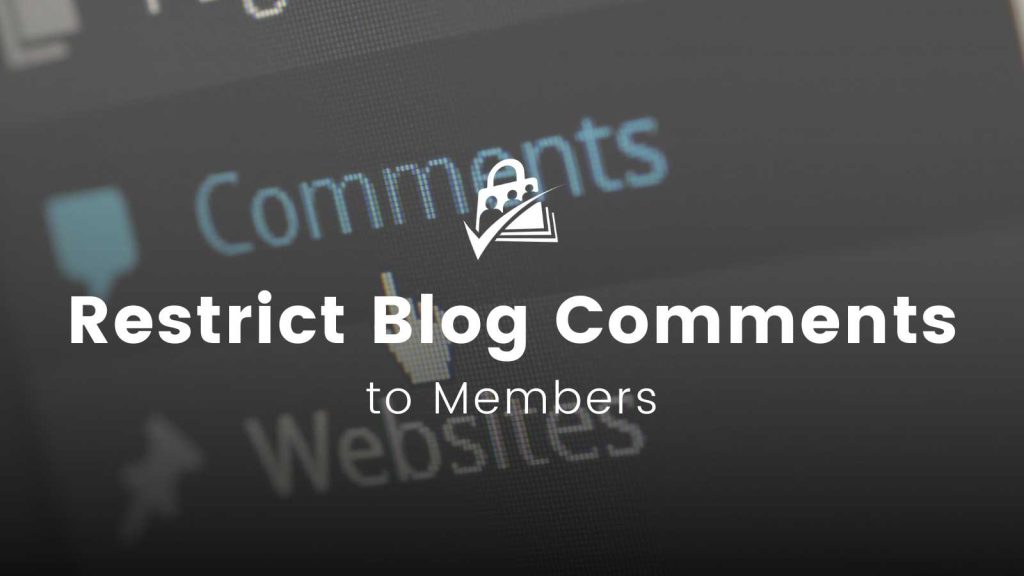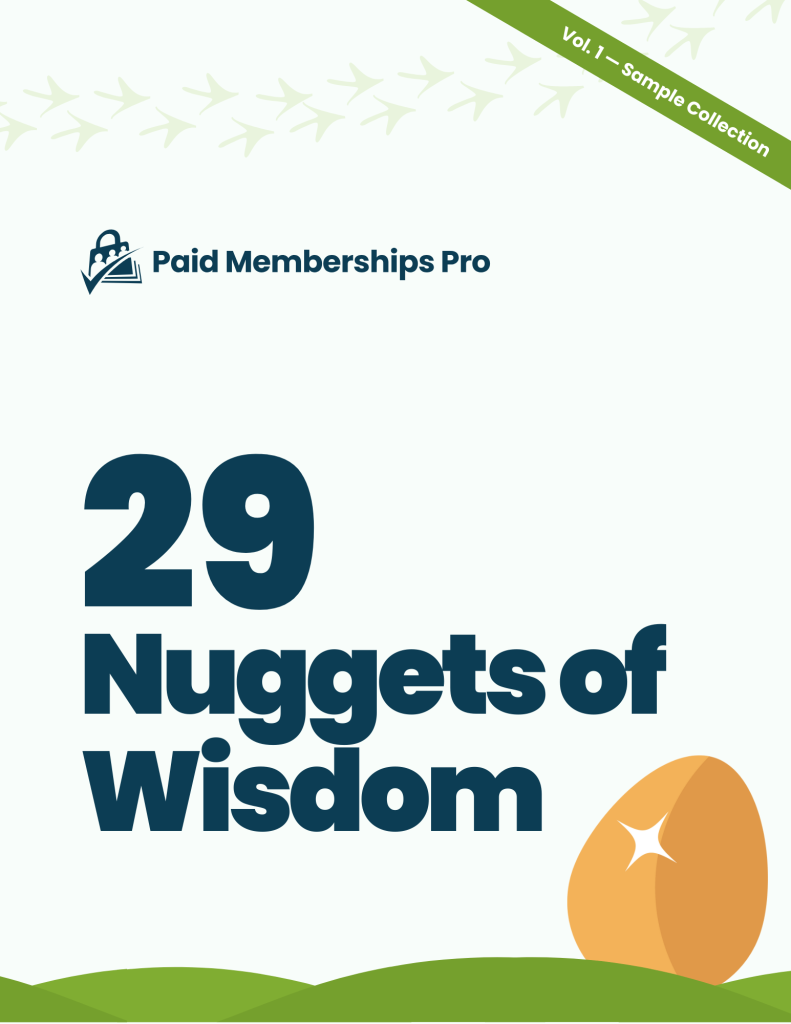If you’re running members-only site or a hybrid site where some posts are public, it may be time to consider how to restrict blog comments to members only.
In an era where online content and discussions have become an integral part of our lives, fostering engagement and maintaining a safe environment is crucial for news and blog sites.
But striking a balance between open access and user accountability can be challenging.
This article explores the benefits of granting public access to posts while reserving commenting privileges for logged-in users or paid members. Let’s explore these user access controls and the positive impact they can have on community interactions.

Managing Post Comments in WordPress
Before we dive into members-only commenting, it’s important to first cover the basics of the comment system in WordPress.
Managing WordPress post comments involves a combination of overall settings that apply site-wide, plus the per-post settings to fine-tune comment behavior. Understanding these options allows you to tailor the commenting experience on your website to align with your community and moderation preferences.
Discussion Settings Screen in WordPress
To manage your WordPress site’s general comment settings, navigate to Settings > Discussion in the WordPress admin. This screen allows you to control various defaults including:
- Enabling/Disabling Comments:
- The “Default article settings” section allows you to enable or disable comments on new posts.
- Tick the “Allow people to post comments on new articles” checkbox to enable comments or uncheck it to disable them.
- Comment Moderation:
- The “Before a comment appears” section lets you define moderation rules for comments.
- Choose whether to require manual approval for first-time commenters
- Automatically place comments in moderation if they contain specific trigger words.
- Consider holding comments in the moderation queue if they contain a certain number of links.
- Comment Display Options:
- Choose whether to display comments in chronological or reverse chronological order.
- This section also includes the option to enable threaded/nested comments and set the number of comments per page.
At the single post level, WordPress has comment settings in the Discussion panel located in the WordPress editor’s sidebar.
- To enable comments for a specific post, check the box to “Allow comments”.
- To disable comments for a particular post, uncheck the “Allow comments” box.
All this being said, your theme also plays a role in how comments function in your WordPress site. Your theme may or may not load comments on posts. In addition, your theme may or may not allow comments on pages.
The global settings described above apply to both pages and posts. Likewise, the Discussion panel is present on both the Edit Post and Edit Page screen.
So no matter what your theme allows, the steps above regarding are everything you need to control basic WordPress comments for all visitors and users.

Power Your Publishing with a Platform You Can Control
Paid Memberships Pro is the best tool for online publishers: an open source WordPress plugin that transforms your blog or news site into a revenue-generating platform.
Tailor your site to engage readers, monetize content, and grow a loyal subscriber base. Give your subscribers the premium content they seek and earn a reliable income with a totally independent online business.
Why You Should Restrict Blog Comments to Members
When it comes to running a successful website, fostering user engagement and facilitating meaningful discussions are key. That’s why many bloggers and news sites look to the comments area as an important thing to get right. If your comments become full of spam, impossible to moderate, or otherwise meaningless, you have very little chance of anyone showing up to your content and deciding to take precious time to voice their valuable opinions.
Garbage-filled comment sections present writers with a really tough choice: should we just disable comments entirely? Is there any way to give legitmate readers a space to communicate with me, and one another, without the general public’s useless words?
There is a way: restrict blog comments to members only.
We share three key ways to protect comments later in this guide. But first, here’s a few reasons why privatizing comments is such a winning approach:
1. Creating a Safer Environment
By restricting commenting to logged-in users or paid members, news and blog sites can significantly reduce the potential for spam, abusive behavior, and trolling.
This access control measure provides an additional layer of accountability, as individuals are more likely to consider the consequences of their actions when their identities are known.
Consequently, a safer and more respectful environment is fostered, encouraging meaningful discussions and reducing instances of toxic behavior.
2. Encouraging Quality Contributions
Allowing public access to posts ensures inclusivity, allowing anyone to read and benefit from the content. However, by limiting commenting privileges to registered users or paid members, sites can prioritize quality contributions.
This approach encourages individuals who are genuinely interested in the topic to engage in thoughtful and constructive discussions, enhancing the overall value of the comments section.
It also discourages drive-by comments and encourages more in-depth exchanges.
3. Promoting Community Building
Membership sites often attract dedicated individuals who are passionate about a particular subject matter. By requiring users to log in or become paid members to comment, these sites foster a sense of community and belonging. Shared interests and a common purpose create a cohesive environment where users are more likely to engage in meaningful conversations, exchange ideas, and build connections. This sense of community can lead to increased loyalty, advocacy, and active participation.
4. Monetization Opportunities
Implementing user access controls for commenting can serve as a revenue stream for news and blog sites.
By offering exclusive commenting privileges to paid members, sites can incentivize users to subscribe or become members, thus generating a recurring source of income.
This approach aligns with the evolving digital media landscape, where the value of quality content is increasingly recognized and monetized through subscription models.
5. Balancing Privacy and Public Discourse
Striking a balance between privacy and public discourse is a crucial consideration for any online platform.
Allowing public access to posts ensures the dissemination of information and promotes open dialogue. However, restricting commenting to logged-in users or paid members provides a measure of control and accountability.
This approach safeguards user privacy by minimizing the risk of unwanted interactions and fosters an environment where individuals feel comfortable expressing their opinions without fear of repercussion.
How-to Video: 3 Ways to Protect WordPress Comments for Members-Only
How to Restrict Public Access to Comments in WordPress
There are a few methods you can use to privatize comments in your WordPress membership site. These methods vary based on your theme, page builder, and technical skills (but all require you to be using the Paid Memberships Pro plugin).
Method 1: Hiding Comments in a Block Theme
- Edit the Block Theme Template
- Navigate to Edit Site to access the WordPress full site editor.
- Identify the template or template part responsible for rendering the comments section. This is usually the Single template.
- Insert the Membership Required Block
- Before the Comments block in the template, insert the Membership Required Block.
- Move the Comments block inside the Membership Required Block wrapper.
- Customize the Membership Required block settings to match the conditions of your membership access rules.
- Optionally check the box to show the “No Access” message so that non-members will see that something is hidden from their view.
- Save and Update the Template and Site
- After making the necessary modifications, save the changes to the template file.
- Visit your site as a member and a non-member to confirm your comments template is properly protected.
Code Recipe 2: Hide Comments in a Classic Theme Template
In most WordPress sites, the single.php template is the file that loads comments for public view. Alternatively, if you theme loads a file like comments.php, you can also make this edit there.
The steps will vary greatly for every theme, but for a basic theme, you will need to either edit your main theme files (not always recommended since updates will break customizations) or your child theme (preferred).
Locate the single.php template and try to find a spot with code like:
comments_template();
You need to wrap this statement in the pmpro_hasMembershipLevel() function described here.
Code Recipe 3: Restrict Non-Members From Posting Comments
This final recipe is the drop in code that will prevent non-members from posting comments. This recipe is best used if you want to keep the post and all existing comments private, but restrict access to new comments based on membership level.
You can add this recipe to your site by creating a custom plugin or using the Code Snippets plugin available for free in the WordPress repository. Read this companion article for step-by-step directions on either method.
Wrapping Up: Private Comments FTW
The implementation of user access controls for commenting strikes a balance between open access and user accountability.
By granting public access to posts while reserving commenting privileges for logged-in users or paid members, news and blog sites can create a safer environment, encourage quality contributions, promote community building, and unlock monetization opportunities.
As online platforms continue to evolve, finding innovative ways to enhance engagement while ensuring user security remains paramount.
Monetize Your WordPress Blog with Paid Memberships Pro
Whether you’re adding a premium content subscription to an existing business or creating an entirely new blog or news website, PMPro has all the tools to help you earn a reliable income from your content without breaking the bank.
We know that a WordPress site has tons of moving parts. Choosing the right plugins, themes, hosting, third party services, design assets, and more can feel overwhelming.
Paid Memberships Pro is the most robust membership plugin to create a premium content subscription business on WordPress. Learn exactly what you’ll get — the plugins, the support, and the training — when you sell memberships on your blog or news site with Paid Memberships Pro.


